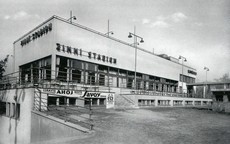
80 years ago, the winter stadium on Štvanice opened to the people of Prague
 |
The plan to build a winter stadium on the island between Karlín and Holešovice was conceived at the end of the 1920s. The building project in the functionalist style was developed by architect Josef Fuchs, who also designed the nearby Trade Fair Palace. The plan did not include a roof over the rink, and it was actually used for open-air skating until the mid-1950s.
Construction of the ice arena began in 1930 and lasted for about two years. The stadium was dominated by a stark restaurant building that also served as the venue for visitors and administration. Its tiered back wall served as the main grandstand.
Behind the stone entrance structure, there was a rink measuring 94 by 32 meters, divided into areas for free skating and hockey. The cooling equipment supplied by Brno Machine Works was reportedly capable of creating ice four centimeters thick in two hours.
Throughout its eighty-year history, the stadium on Štvanice became the venue for a number of significant sporting events. As early as January 1931, players from Prague's LTC faced off against the Canadian club Manitoba on its ice. The historically first match played on artificial ice in our country was attended by 7,000 spectators. And for completeness: the match was won by the hockey players from the land of the maple leaf with a score of 2:0.
Štvanice also made its mark in the history of domestic sports in 1947, when Czechoslovak hockey players won the world championship title on its ice. In February 1955, the stadium also entered the history of television broadcasting in Czechoslovakia, when the first television broadcast of a hockey match was aired from there.
The Ice Hockey World Championship was held at Štvanice a total of four times (1933, 1938, 1947, and 1959). However, the stadium was not only dedicated to fierce hockey battles. Anyone could skate on it, and with a bit of luck, they might even catch a glimpse of skating legend Ája Vrzáňová preparing for competitions.
Due to sporting events, the stadium was roofed in the mid-1950s. The wooden structure that rose above the rink did not match Fuchs' entrance building too well, but most people still associate Štvanice with this wooden building.
From the early 1960s, the significance of Štvanice began to decline. A modern sports hall (today's Tipsport Arena) was opened at the nearby Exhibition Grounds, into which all significant events relocated. Consequently, the flow of funds for the operation and maintenance of Štvanice began to dwindle.
The last major repairs the stadium underwent were in 1968, and since then it has only deteriorated. Over time, individual parts of the complex had to be closed, until finally, the ice surface itself could no longer serve.
In the mid-1990s, a civic association called APeX CLUB contributed to the revival of the "zimák." However, at the beginning of 2011, a cold shower arrived. Part of the roof collapsed at the stadium, and the building office ordered its closure.
Even the status of a cultural monument did not protect the building from demolition. The start of demolition work at the end of last May caused an uproar, but just a month later, not a trace remained of the wooden structure.
The future of Štvanice is now open. The city hall announced a two-round architectural competition for the use and development of this Vltava island at the beginning of October this year. The results are to be announced next year. It is possible that the stadium will regain its original form with an open-air rink, as proposed by architectural historian Zdeněk Lukeš, for example.
The English translation is powered by AI tool. Switch to Czech to view the original text source.
0 comments
add comment
Related articles
0
07.03.2022 | Před 60 lety byla otevřena Sportovní hala v Praze, dnešní Tipsport arena.
Sixty years ago, the Sports Hall in Prague, now known as Tipsport Arena, was opened.
0
05.11.2017 | 85 years ago, the stadium at Štvanice was opened, today it is already a thing of the past
9
09.02.2013 | Experts are selecting from architectural designs for the restoration of Štvanice
0
18.09.2012 | Prague approved the conditions for the public competition for the use of Štvanice
0
23.03.2012 | The Prague City Hall promised a competition for the solution of Štvanice Island
0
18.08.2011 | Police: The council acted in accordance with the law during the demolition of Štvanice
0
07.06.2011 | The heritage preservationists fined Prague and the tenant for the poor condition of Štvanice
0
02.06.2011 | NPÚ wants to negotiate with the magistrate on the preservation of valuable parts of Štvanice
3
01.06.2011 | Heritage protectors request the halt of the demolition of the stadium in Štvanice
1
28.05.2011 | In Prague, the demolition of the ice rink in Štvanice began today
0
28.05.2011 | The winter stadium on Štvanice has served sports and entertainment since 1932











